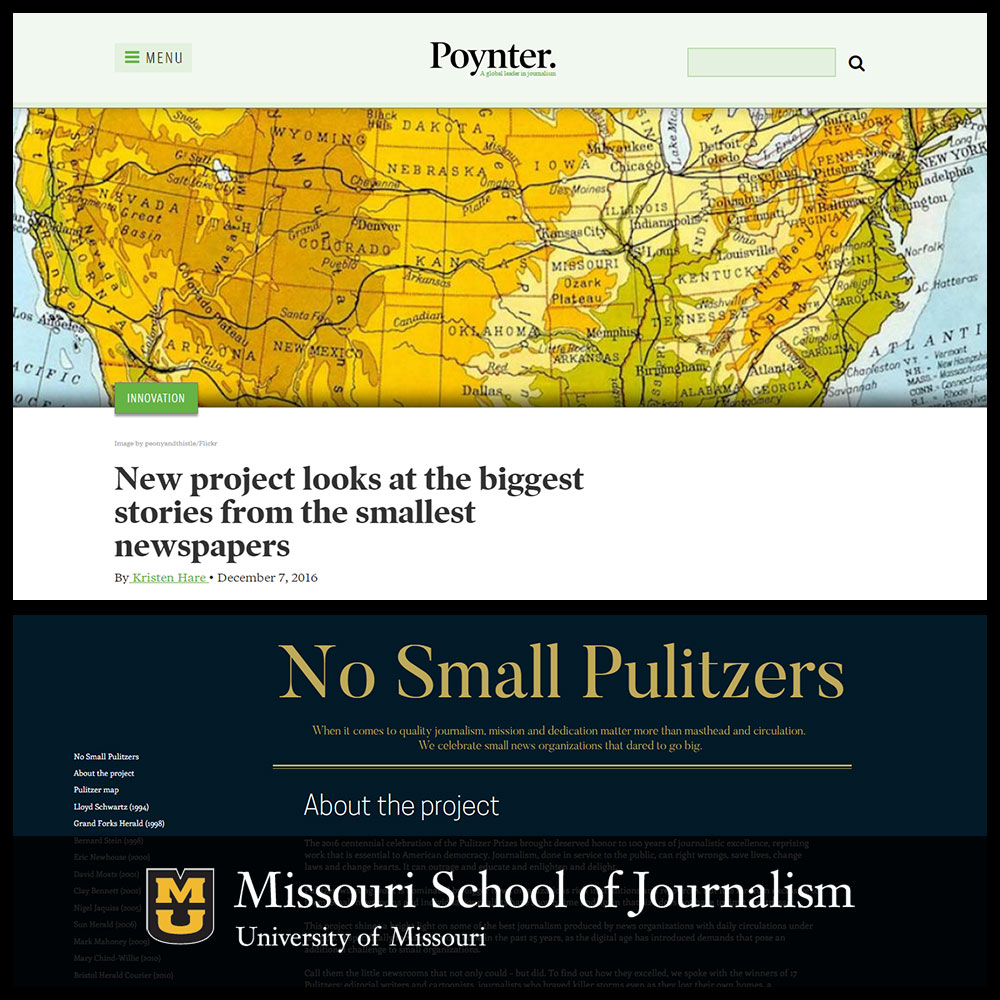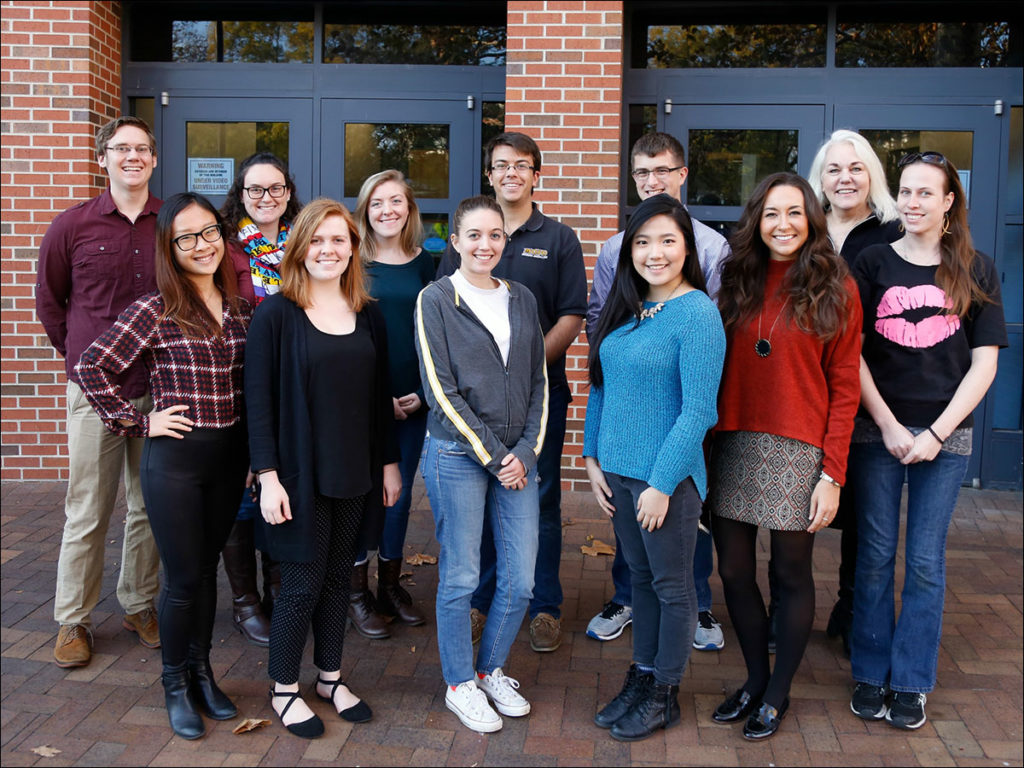Student Project on Pulitzer-Winning Work Captures Attention of Professionals

“No Small Pulitzers,” a student project at the Missouri School of Journalism, is based on interviews with journalists from 17 Pulitzer-winning projects published between 1991 and 2016.
‘No Small Pulitzers’ Is Based on Interviews with Journalists from 17 Pulitzer-Winning Projects Published Between 1991 and 2016
Columbia, Mo. (Dec. 17, 2016) — A student project at the Missouri School of Journalism, focusing on Pulitzer-winning work by small news organizations in the digital age, has caught the attention of professional journalism organizations and working journalists.
“No Small Pulitzers” was featured in a story by the Poynter Institute, on the official Pulitzer website and in social media posts shared by working journalists and journalism educators.

The project was the work of 11 Print and Digital News seniors in their capstone class, “Journalism and Democracy.” The students worked as a team to conceive, report, design and produce a substantive package based on interviews with journalists from 17 Pulitzer-winning projects published between 1991 and 2016.
Poynter.org featured the project in a Dec. 7 centerpiece by Kristen Hare, BJ ’00. The story underscored the lessons students took from the project. Among them, Hare reported:
- The digital revolution hasn’t changed all that much about really good journalism.
- Pulitzer winners are pretty normal folks.
- You can do big things at small places.
In summarizing one of the stories – an interview with Willamette Week reporter Nigel Jaquiss by Missouri student Kelsi Anderson – Hare wrote: “She had detailed, tough questions. She was diligent with fact checks. She produced a podcast. She wrote a Q&A. And she spent time on something many students often gloss over – the impact of Jaquiss’ work on the community.”
The Pulitzer Prizes organization highlighted the project on its site as one of the centennial Campfires Initiatives celebrating 100 years of Pulitzer Prize-winning journalism. Students worked with Pulitzer administrator Mike Pride to get support for the project as part of the #Pulitzer100 efforts promoted through Twitter and Facebook; a video of some of the students’ experience is scheduled to be posted on the Pulitzer Facebook page next week.
Roy J. Harris Jr., author of Pulitzer’s Gold, a history of winners of Pulitzer for public service reporting, posted that he was “inspired” by the students’ work.
“Obviously it’s great to have your work recognized, but it’s a special feeling when you have prestigious groups pick up your project and broadcast it to a greater audience,” said Jacob Scholl, a student who grew up in South Dakota and Chicago. “The project was a great way to expose our generation of journalists to those in the senior level of the field and display what we can learn from them.”
The project was guided by Jacqui Banaszynski, the endowed Knight Chair Professor in Editing at Missouri, a faculty fellow at the Poynter Institute and a Pulitzer Prize winner and finalist. She said she gave the class several options for the capstone project, but imposed some core requirements: The project had to meet professional journalistic standards, be of use to journalists and journalism educators, be produced with appropriate digital tools and be made available to the public.
“This is the Missouri Method at work,” Banaszynski said. “The goal was to give the students a last big stretch of learning as they head into their own careers, but also to underscore that journalism is done in service of the public. In other words, to have them learn journalism by doing journalism.”
To accomplish that, the project team talked a lot about audience. They decided they wanted to produce a body of work that would be both inspiring and useful to other journalism students and young journalists who want to know what it takes to do top-level work. They focused on smaller news organizations that have limited resources, hoping to show that circulation and staff size do not have to limit quality. And they zeroed in on work done in the last 25 years as the digital revolution has presented both greater opportunities but greater challenges to those small newsrooms.
As Poynter’s Hare noted in a Twitter post: “By digging into small Pulitzer wins, @JacquiB’s capstone class learned this semester that ‘masthead is not destiny.'”
Banaszynski said she was especially gratified that her students put the spotlight on smaller newsrooms. Her own career started in community journalism. And as the legacy industry contracts, she said, it’s essential that tomorrow’s journalists see how they can have fulfilling careers and provide value to society apart from the big-name newspapers.
“What’s most important in journalism is the person and the story in front of you, not the brand above your byline,” she said. “I want our best Missouri students to be working across the spectrum of community service, and doing it with a sense of purpose and joy.”
The students designed a website for “No Small Pulitzers” on Wix, and faced inevitable technological limitations and glitches they are still working to resolve. In addition to the stories they wrote, they gathered photos, built a map, produced a podcast interview and a behind-the-scenes Storify about the project. A second Storify captured some of the industry reaction after the project was published.
“We’ve been chipping away at ‘No Small Pulitzers’ over the past three months, so it’s been really fulfilling to watch journalists outside MU respond to our project in a positive way,” said Thomas Friestad, a senior from Fairfax, Virginia. “I like that we had the opportunity to go behind the scenes with different Pulitzer winners, because many journalists seek to focus on their subjects and avoid ‘becoming part of the story’ themselves.”
Friestad is one of the students who learned a deeper lesson from “No Small Pulitzers.” As a D.C.-area native and a self-described political junkie, he was set on a reporting job covering national politics. This week, he accepted a job covering city government at the Bucks County Courier Times outside of Philadelphia. “I’ll get to cover policy and issue stories that affect area residents across different boroughs,” he posted on Facebook. “In other words, given my interests, it’s a perfect position for me.”
Updated: October 9, 2020